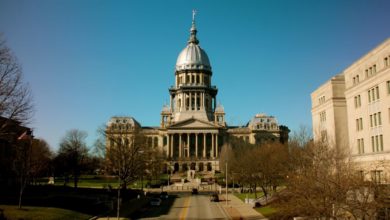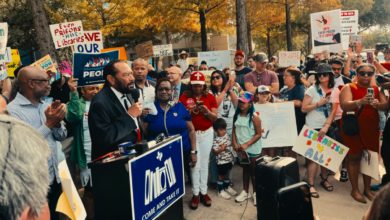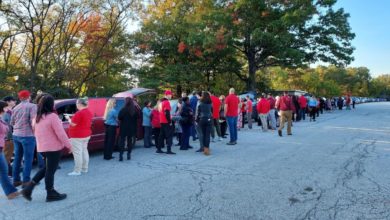Photo credit: Liberation screenshot of KOAT coverage.
On Feb. 3, teachers and students held a protest outside of Albuquerque Public Schools administrative headquarters against the rushed re-opening of schools. They chanted “Save lives, keep the schools closed!” and “Until cases decline, stay online!” Later that day, the APS Board of Education met to vote on a “re-entry plan” to force teachers and students back into in-person schools.
In response to mass public outcry, this vote was delayed until at least Feb. 17.
School administration, NM governor want schools back in-person
Last March, New Mexico schools went fully online, and “virtual learning” has continued into the current school year. Albuquerque Public Schools provided a laptop or other device to all students and worked with Internet providers to provide cheap Internet. Cafeteria workers were reassigned to provide drive-through meals for students. Teachers adapted too, planning lessons, facilitating classes, and grading online. While both teachers and students have struggled, the shift to virtual schooling has been largely successful and has undoubtedly prevented the spread of the virus by eliminating a major center of potential disease spread.
Now, Democratic Governor Michelle Lujan has greenlit districts to open schools to in-person learning as early as Feb. 8. APS is the largest school district in the state. Its decision to stay virtual or return to in-person will have a much larger impact and may set a precedent for the rest of the state.
The APS Board of Education is deliberating on a proposal to transition to “hybrid learning” starting Feb. 16 and complete by March 8. Hybrid learning means students would alternate between online and in-person school — half of students would go to school one day, half of students the other day, which would still mean hundreds of students, teachers and staff on site.
Many teachers, students unsure and skeptical
Teachers, district administrators, state lawmakers and students and their families nationwide are discussing the question of returning to school in-person. Some recent studies have pointed to a low COVID risk for returns to in-person school, but only when community spread, cases, and hospitalizations are low. In New Mexico, both cases and hospitalizations are declining slightly, but only in very recent weeks. The risk of outbreaks is still undoubtedly high, as a recent massive outbreak in Michigan schools shows. Just weeks before the outbreak, Michigan Democratic Governor Gretchen Whitmer had been “strongly encourag[ing]” schools to reopen.
On the day of the APS board vote, teachers and students filled the administrative headquarters in protest. Teachers spoke on a microphone about how, even in normal times, schools are not up to code, with leaking or crumbling ceilings and lead-contaminated water fountains. Bus drivers spoke about how impossible it will be to enforce masks, snack sharing, and keeping students physically separated while driving.
A small group of about 15 people counter-protested on the south side of the building demanding that schools re-open.
But on the north side of the building, teachers pointed out that case numbers are actually higher now than they were in March and April, when virtual learning began. They pointed out that APS adopted a plan in December to return to in-person learning when the county was “in the green” again (referring to the state’s red-to-green rating of COVID conditions), but is now moving to re-open despite the county still being “in the red.” Teachers shared the concerns of students, one saying simply, “I don’t want to die.” Students said that virtual learning, while difficult, is worth avoiding the risk of losing loved ones. Cars circled with signs like “Safety First” and “Keep Schools Closed.”
APS has attempted to encourage teachers to return after vaccination. However, several protesting teachers and students pointed out that just because teachers are vaccinated, students and their families would not necessarily be safe. The current vaccination timeline in New Mexico indicates that most students would not receive the vaccine until at least next summer. And even if young people don’t show symptoms, they can carry the disease to others and to their families. It was pointed out that in the low-income families common in Albuquerque, students often are raised by or living with their grandparents and other older relatives, who would be especially at risk.
In addition, scientists are still unsure if current vaccines can fully protect against all COVID variants, as well as if vaccinated people can still carry the virus.
Teachers pointed out the importance of consistency and predictability in education. Returning to in-person school, only to return to virtual when someone tests positive is the opposite of the consistency students need. There is nothing more disruptive than a student being hospitalized or losing a family member.
After the protest, teachers and families watched the Board of Education meeting (virtual, due to COVID) for hours as the Board debated. In the end, the decision was postponed. It was clear that too many questions remain unanswered.





